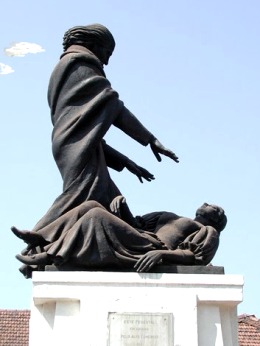Pioneer of modern hypnosis
 Our tiny state of Goa has no dearth of illustrious personalities. But let’s begin by turning the spotlight on one of the earliest non-resident Goans to make a mark on a global level, who introduced the West to the benefits of hypnotherapy and hypnosis in healing people, who engaged in pioneering work in the study of the mind, and became a legendary figure inspiring a writer like Alexandre Dumas to immortalize him as a fictitious character in his classic adventure novel – “Count of Monte Cristo”.
Our tiny state of Goa has no dearth of illustrious personalities. But let’s begin by turning the spotlight on one of the earliest non-resident Goans to make a mark on a global level, who introduced the West to the benefits of hypnotherapy and hypnosis in healing people, who engaged in pioneering work in the study of the mind, and became a legendary figure inspiring a writer like Alexandre Dumas to immortalize him as a fictitious character in his classic adventure novel – “Count of Monte Cristo”.
That gentleman’s name was Jose Custodio Faria. Doesn’t ring a bell? Maybe you’ve heard of the name Abbé Faria, the name given to him by the French, or Abade Faria, the Portuguese version of his name. In English this would translate into Abbot Faria. Yes, he was a Catholic priest, one of the pioneers of modern hypnosis in the world, and a Goan. A great Goan.
Unfortunately, Abbé Faria is one of those forgotten greats. It’s such a shame that many Goans are unable to go beyond associating his name with a major road in Margao – Rua Abade Faria, or maybe the monument in the capital city of Panjim. Everyday hundreds of people pass by the Old Secretariat building, the former palace of Adil Shah near the Panjim waterfront. There’s a bronze statue close by, actually a striking sculpture if you look at it closely, that might be just a part of the scenery for most of them. Not many will pause to admire the life size statue of a long-haired monk, hands outstretched as he hypnotizes a young lady about to collapse on her back, one dainty foot still in the air. Or read the inscription at the base of the statue: Jose Custodio, Abbé Faria, fundador do metodo de hipnose pela sugestao (founder of the method of hypnotism by suggestion). The statue, sculpted by the award winning Goan sculptor Ramchandra Pandurang Kamat, the first Indian to be awarded a Gold Medal by the Royal Academy of Arts, London, was erected in 1945 as a tribute to a distinguished son of Goa.
An interesting family history
Jose Custodio Faria was born in 1756 in Portuguese-ruled Goa to Goan parents, his father being a Catholic bamonn (Brahmin) from Colvale. He was born in his mother’s house at Candolim. The house still exists and has been converted into a house for orphans by the Government of Goa; somewhat apt since his sister was an orphan adopted by his parents.
What is interestingly unconventional about his parentage however is that his father was a priest and his mother was a nun! It happened like this. Around eight years after he was born, his parents separated. Having abandoned studying for the priesthood earlier on to get married, his father rejoined the seminary, while his mother joined the St. Monica Convent in Old Goa to become a nun, rising to the position of prioress in later years.
At the tender age of 15, Faria Jr. and his father sailed off first to Lisbon and from there to Rome where both of them acquired doctorates in theology and were ordained priests before returning to Portugal in 1780. By then, young Faria had also completed a doctorate in philosophy from the University of Rome. A few years later, his father was arrested for his involvement in the Pinto Revolt, a conspiracy by the Catholic clergy for overthrowing colonial Portuguese rule in Goa, making him flee to Paris. There, influenced by French radicals, he took active part in the French Revolution and got thrown into a dungeon in the island prison of Chateau d’If. (The Abbé Faria in Dumas’s Count of Monte Cristo was also incarcerated here.) Many prisoners were known to go mad during confinement in this infamous prison. But not Abbé Faria. During his 17 long years of imprisonment he practised and mastered the techniques of mind control and auto-suggestion.
Hypnotherapy and Hypnosis
After his release, Abbé Faria began a scientific study of the mind and of somnambulism as he referred to his research (the terms hypnotism, hypnotherapy and hypnosis being coined much later). He rejected Mesmer’s theory that hypnosis was made possible by ‘animal magnetism’ and was the first to assert that it worked through the power of suggestion.
Abbé Faria cured thousands of patients even as he taught as a professor of philosophy in Marseilles and Nimes. But his work and experiments in hypnotism were denounced by the church authorities and some other scientists who branded him as a propagator of occult practices. Ironically, his seminal work titled De la Cause du Sommeil Lucide (On the cause of lucid sleep) published just before he died in 1819 is acknowledged today as a valuable contribution to the study of the hypnotic sciences.
Kator re bhaji!
 An interesting anecdote is told of how on returning to Portugal with two doctorates under his belt, Abbé Faria was invited by the Queen to preach at her chapel to a congregation of the Portuguese nobility. But seeing that, after ascending the pulpit, his son was unusually tongue-tied, his father who was standing close by urged him in his native Konkani, a language no one else in the august gathering understood, “Puta, hi sogli bhaji; kator re bhaji!” (Son, they’re all veggies, grass heads; go cut the veggies!) Meaning: This is a simple task, just do it! Shaken out of his stupor, the young abbot then vowed the listeners with his preaching. This incident is believed to have sparked Abbé Faria’s interest in the power of suggestion and the science of mind control.
An interesting anecdote is told of how on returning to Portugal with two doctorates under his belt, Abbé Faria was invited by the Queen to preach at her chapel to a congregation of the Portuguese nobility. But seeing that, after ascending the pulpit, his son was unusually tongue-tied, his father who was standing close by urged him in his native Konkani, a language no one else in the august gathering understood, “Puta, hi sogli bhaji; kator re bhaji!” (Son, they’re all veggies, grass heads; go cut the veggies!) Meaning: This is a simple task, just do it! Shaken out of his stupor, the young abbot then vowed the listeners with his preaching. This incident is believed to have sparked Abbé Faria’s interest in the power of suggestion and the science of mind control.
Tributes
In 2006, to mark his 250th birth anniversary, Portugal released a postcard of Abbé Faria’s Panjim monument. In Goa, Prof. Isabel de Santa Rita Vas staged a play titled “Kator re bhaji!” celebrating his life. The previous year, Vas and Cecil Pinto, the popular Goan columnist produced and released a documentary – “In search of Abbé Faria: the Hypnotic Vision of a Goan Pioneer”.
Eminent Goans like Abbé Faria are an inspiration for future generations. So, the next time you visit Goa, spare time to visit the tales of the past. Don’t just take your children and grandchildren for romps on the beach. Show them our rich cultural heritage and enlighten them about our treasure trove of luminaries.
Cheers!
Suggested further reading:
http://www.abbefaria.com/The%20Revolutionary%20Abbot.htm
An excerpt from the book Child Psychiatry and You by Dr. Mikhail Buyanov, President of the Moscow Psychotherapeutic Academy, and also the author of a book on Abbé Faria : A Man Ahead of His Times.
http://www.abbefaria.com/Sommeil-Luis.htm
A summary of Abbé Faria’s long treatise on lucid sleep in English by Luis S. R. Vas.

I am much indebted to the great master Shree Abbe Faria for his work. I have always been more interested in knowing the great soul’s wisdom and approach to healing the sick.
My namaskaram to the great master Abbe Faria. Veena Patwardhan-ji Namaskaram!
Namaskaram to you too Shri Chowdary as an admirer of Abbe Faria – a great son of Goa and the father of modern hypnotism!
A salute to the great son of Goa for his contribution towards the study of hypnotism and enriching the history of Indian pioneers. Am very enthusiastic to know about the impact of hypnosis in the healing process and in mind control.
Many thanks to you Veena-ji for your article about Abbe Faria.
The great Goan Abbe Faria certainly deserves many salutes.
Hi. Thanks very much for this very interesting blog post and anecdotes. I did not know that the character Abbe Faria from the Count of Monte Cristo was of Goan origin. The fact that he developed the science of hypnotism and was part of major political movements in 2 parts of the world is an extraordinary accomplishment. We will surely visit his statue when visiting Goa the next time.
Thanks Deepak. One of the important characters in that well-known novel was not only loosely based on the Goan pioneer’s character but the writer Alexandre Dumas even gave the character the same name. So in a way, you could say a great Goan has been immortalised by Dumas in his world-famous book.
Thank you for this. I am a hypnotist from India based in Las Vegas and was taught about Abbe Faria by one of my mentors. I will be visiting the location in a day and this article provided me with the location information. Truly appreciate the location info.
You’re welcome.
I am so glad to learn about the great person – ”The great son of Goa” – Abbe Faria.
Glad you enjoyed reading the post, Daisy.
I visited the orphanage in goa in 1989. The strange thing about this man is that no one has heard of him in the west. His only testament is his book. I urge you to promote it and maintain his legacy. He was one of India’s greats. Also I think he deserves his body to be repatriated to India. It is unknown where he is buried. Certainly a truly amazing story. His time in prison must have focused his mind even further.
My apologies for the late response. I agree. Abbé Faria was not only a great Goan, but a great Indian too. His legacy needs to be preserved, but I believe this has to be done at the State level. Cultural institutions in Goa like the Institute Menezes Braganza, Kala Academy, and the Directorate of Art & Culture are in a better and more powerful position to do this.
Namaskaram Veena, I am extremely enlightened by the way you have put forth the reality of our great son of Goa, an immortal soul, in a simple, yet so interesting manner. I feel proud of you. God bless!
Many thanks for appreciating my work, Antonio.